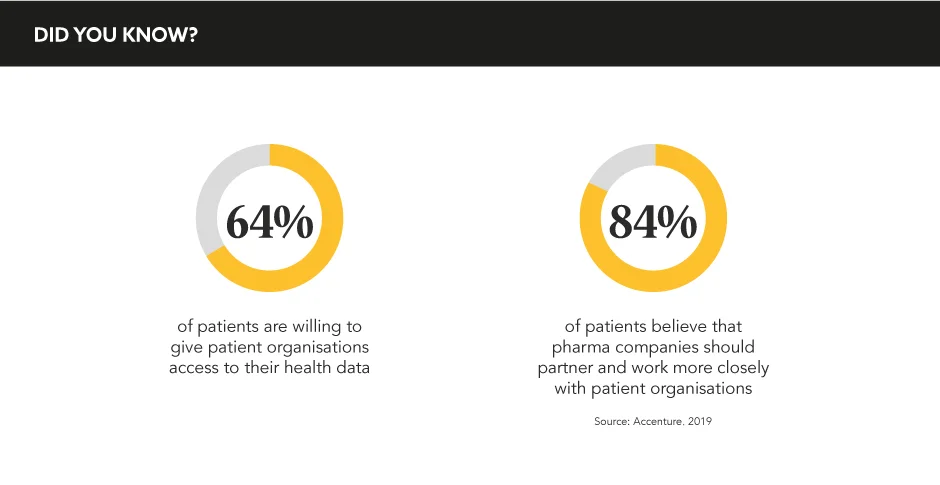Words by Kirstie Turner
In pharma’s bid to achieve the ultimate award of ‘Most Patient-Centric’, medical affairs has been cast in the leading role, utilising their unique résumé to bring the patient voice to the drug development process. However, there is still a long way to go in achieving this momentous goal and no great lead is complete without their supporting cast. Collaborating with patient organisations offers fruitful opportunities to bring the patient voice to the table ahead of opening night. MA must build and nurture relationships with these organisations to put on an Oscar-worthy performance and deliver true value for patients.
The benefits of such partnerships are multi-faceted, as Dr Danie du Plessis, Executive Vice President, Medical Affairs (EMEA), Kyowa Kirin and Medical Affairs Professional Society (MAPS) Board Member and President (EMEA) says: “Partnering with patient organisations allows the opportunity to include clinical outcomes that are important for patients in clinical studies. It also creates an opportunity to collect real world evidence early on, which, in turn, can be used in access to medicine negotiations.”
But while the benefits are acknowledged, patient organisations only make their appearance in Act 2 – earlier adoption in the development cycle is sorely needed, as du Plessis continues: “Collaboration with patient organisations has increased tremendously over the last decade or so, but there is still room for improvement. These days, it is quite common to engage with patient groups during late-stage development and after marketing authorisation.” This late-stage engagement is a step in the right direction, but without involving organisations from day one, companies are not championing the patient voice at arguably the most important stage.
This can create a situation where new medicines do not address what is really important to patients, as du Plessis explains: “There are multiple examples where regulatory requirements for new medicines have not taken the effect on, or perspective of, the patient into consideration. For example, studies of lung disease medicine must include lung function tests, which of course is important, but these studies often neglect to take these physiological tests and translate them into what is important for patients. Patients really want to know if their shortness of breath will be better and whether they will be able to be more active.” Without asking patients what matters to them and involving them in the process, pharma is merely making assumptions.
And late-stage adoption could even be perceived as a marketing tool solely aimed at attaining rave reviews, as opposed to truly delivering value. Vanessa Pott, Director, Patient Advocacy and Strategic Partnerships, Merck Group reaffirms: “What we need to be looking at as an industry is how that engagement takes place: is it merely transactional? Are we asking patient organisations to provide a quote for a press release upon the approval of a new drug or are we partnering in a strategic way along the entire research and development process?” Pharma is striving to demonstrate how they are championing the patient voice, but MA must advocate for early adoption to ensure that these partnerships are organic. Pott continues: “Our main goal must be to strategically engage with patients and make sure that the insights we obtain shape our decision making.”
It is no secret that pharma is working towards better patient involvement and focus; direction from the top levels of pharma is needed to empower MA on this mission to create and nurture patient organisation relationships. Trishna Bharadia, Health Advocate and Patient Engagement Champion discusses: “Internally, a patient-focussed approach needs to be embedded at every level. Where I’ve seen the most success has been when there has been buy-in from the top, which then filters down throughout the company. There is no point in having someone championing the patient voice if they encounter obstacles every time they need something to be approved or budget to be allocated.”
Early partnership between pharma and patient organisations will truly bring the mission of patient centricity to life
MA and patient organisations are just one avenue that must be explored on the patient centricity mission. “Companies also need to explore how to make it easier for patients to get involved – whether that is simplifying the contracting process, creating more opportunities for advocate involvement, rethinking standard operating procedures so that they are more patient friendly, or creating internal frameworks to ensure that the patient voice is being embedded at every single possible point along the drug development lifecycle,” says Bharadia.
Patient organisations allow MA to shine the spotlight on the patient perspective, but it is critical that these partnerships are cultivated and utilised as early as possible, and not as a last-minute, transactional process. Direction must come from the top down and offer support throughout, limiting obstacles for approval and budget allocations – the show must go on, after all. du Plessis concludes: “Early partnership between pharma and patient organisations will truly bring the mission of patient centricity to life.”







